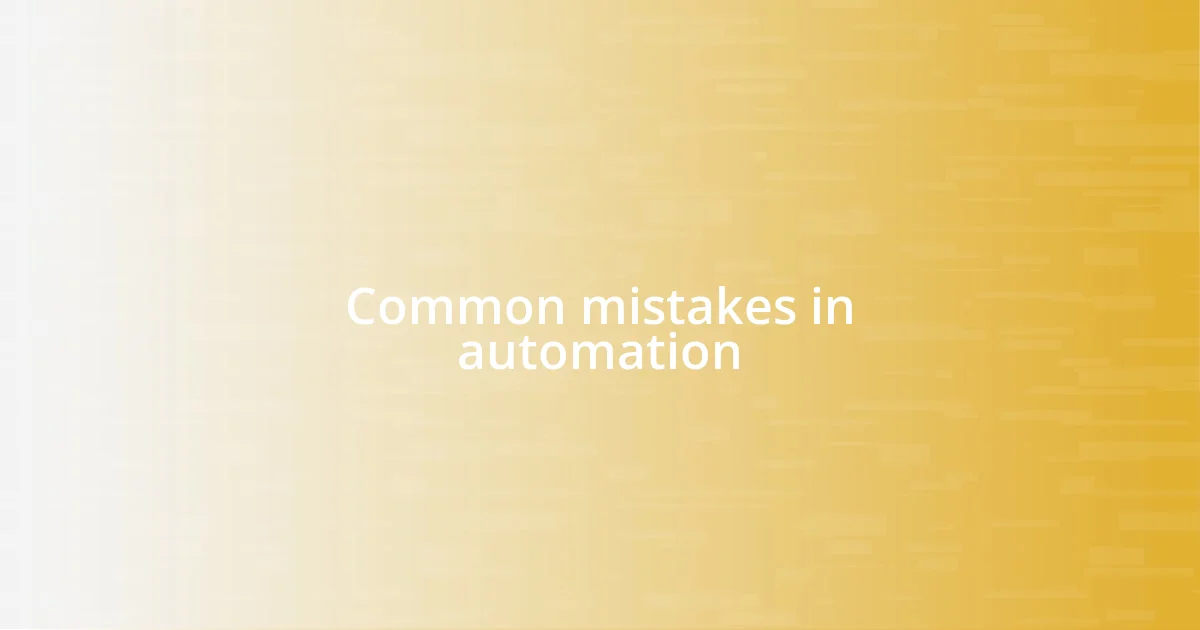Key takeaways:
- Marketing automation saves time and allows for personalized communication, enhancing audience engagement and campaign effectiveness.
- Key tools like HubSpot, Marketo, and Mailchimp help streamline automation processes and analyze performance metrics for continuous improvement.
- Successful automation requires a balance between automated processes and personal touches, along with regular testing and audience segmentation to maximize impact.

Understanding marketing automation benefits
One of the most significant benefits of marketing automation is the time it saves. I remember a time when I spent hours manually sending emails and managing social media posts. With automation, I can plan and execute my marketing strategy efficiently, freeing up time to focus on creative aspects and strategy. Can you imagine what you could achieve with that extra time?
Another advantage is the ability to personalize communication at scale. I’ve seen firsthand how tailored messages resonate more with my audience. Just last month, I used automated workflows to segment my contacts based on their behaviors and interests, leading to a noticeable boost in engagement. Doesn’t it feel great when you know you’re addressing your audience’s specific needs?
Finally, automation provides valuable insights through data analysis. I often analyze metrics from automated campaigns to refine my approach continually. Understanding what works and what doesn’t makes my marketing efforts smarter over time. Do you find that data-driven decisions empower your campaigns too?

Key tools for marketing automation
When it comes to implementing marketing automation, several key tools stand out in the industry. For instance, I’ve had great experiences with HubSpot, which offers a comprehensive suite that integrates CRM, email marketing, and analytics all in one place. Its user-friendly interface helps even those less tech-savvy navigate seamlessly. On the other hand, I’ve seen how tools like Marketo excel in lead nurturing and scoring, allowing for targeted marketing strategies. I recall a campaign where Marketo helped me automate a series of follow-ups based on user interactions, significantly increasing conversion rates.
Another tool worth mentioning is Mailchimp, which I’ve found superb for email campaigns. Its robust automation features and templates simplify the process of triggering emails based on customer actions. I still vividly remember the first time I set up an abandoned cart email; the next day, two customers returned to finalize their purchases! It’s fascinating how a simple email can reinvigorate a lost sale.
Finally, I can’t overlook the importance of analytics tools like Google Analytics in the automation toolkit. These tools provide insights into campaign performance, helping me tweak my strategies accordingly. I feel empowered by the real-time feedback; it reminds me of how crucial it is to adapt quickly to maintain engagement. That’s the beauty of automation—it not only simplifies tasks but also enhances decision-making.
| Tool | Key Features |
|---|---|
| HubSpot | CRM integration, email marketing, analytics |
| Marketo | Lead nurturing, scoring, targeted campaigns |
| Mailchimp | Email automation, templates, user-friendly |
| Google Analytics | Campaign performance insights, real-time feedback |

Implementing automation in your strategy
When it comes to incorporating automation into your marketing strategy, I believe the key is to start small and scale gradually. I learned this lesson the hard way during a large campaign where I attempted to automate everything at once. It felt overwhelming! Opting for a focused approach allowed me to grasp how each element interacts with others. Prioritizing tasks, such as automating follow-up emails or social media posts, can significantly improve efficiency without losing sight of your overall goals.
To effectively implement automation, consider these steps:
- Identify Repetitive Tasks: Start with simple, time-consuming processes like email scheduling or social media posting.
- Set Clear Objectives: Determine what you want to achieve with automation, whether that’s improving engagement or increasing lead generation.
- Choose the Right Tools: Leverage the tools that best fit your needs, ensuring they offer the integration you require.
- Start with Segmentation: Personalize your audience by segmenting your contacts based on demographics or behaviors; this makes your automation efforts more effective.
- Test and Analyze: Regularly review the performance of automated campaigns to make necessary adjustments, ensuring continuous improvement.
Reflecting on a time when I segmented my audience for a specific product launch, I still feel that rush of excitement when I saw open rates soar. It was like a light bulb moment—automation doesn’t just save time; it amplifies impact when done thoughtfully!

Best practices for effective automation
One of the best practices I’ve come to swear by is ensuring that my messaging feels personal, even in an automated setup. I remember launching a welcome series for new subscribers where I crafted personalized messages based on their interests. It made a world of difference! Seeing engagement rates climb reinforced my belief that automation doesn’t have to sacrifice that human touch. Why not take a moment to think about how you can add a personal flair to your automated communications?
Additionally, regularly reviewing your automated workflows can be a game-changer. I often set aside time each month to assess the effectiveness of my campaigns. One time, I discovered that a particular email segment wasn’t performing as I had hoped. By tweaking the subject line and timing, I managed to double the interaction rate. This experience reminded me that automation is not a “set it and forget it” process; it’s essential to fine-tune your strategies based on performance data.
Lastly, integrating feedback loops into your automation can dramatically enhance its effectiveness. I once decided to include a short survey after a customer completed a purchase. The insights I gathered not only improved future campaigns but also deepened my connection with my audience. Have you ever considered how valuable direct feedback can be in refining your approach? Truly, listening to your audience leads to a more engaging automated experience and fosters a sense of community.

Measuring success in automation
Measuring the success of your marketing automation efforts is something I always approach with a mix of excitement and scrutiny. It’s imperative to track key performance indicators (KPIs) like open rates, click-through rates, and conversion rates; these metrics tell a story about how well your automation is resonating with your audience. I recall the thrill of seeing a significant bump in conversions on a carefully timed email campaign I automated—like uncovering a hidden gem in the performance data that confirmed my strategy was hitting the mark.
Another interesting aspect to consider is how customer engagement can illuminate the effectiveness of your automation. When I implemented a series of automated follow-up emails for a product promotion, the emotional response from customers was palpable. The replies I received weren’t just about transactions; they expressed gratitude for the personalized approach. This emotional connection fueled my belief that measuring success goes beyond numbers; it’s about understanding how your audience feels and responds to your brand voice.
After several rounds of analysis, I’ve learned to embrace a culture of constant iteration. The first time I analyzed a drip campaign, I was surprised—what I thought would be the biggest hit turned out to be the least engaging. This unexpected twist made me question my assumptions and ultimately led me to refine my content. Have you ever had a similar experience? It reinforces the idea that success in automation isn’t static; it requires an ongoing commitment to learn from both successes and setbacks while responding to your audience’s evolving preferences.

Common mistakes in automation
It’s easy to fall into the trap of over-automating, which I’ve experienced firsthand. When I tried to automate every single response in my customer service workflow, I quickly noticed frustration from my users. They missed that personal touch and often felt misunderstood. This made me realize that while automation is beneficial, a balance is crucial—some interactions simply require a human response to truly connect.
Another common mistake is neglecting to segment your audience effectively. I remember a campaign where I sent the same generic email blast to everyone on my list. The response rates were dismal, and it hit home when I received feedback that the content was not relevant for many recipients. This taught me that taking the time to tailor messages based on specific audience segments can dramatically improve both engagement and satisfaction. Aren’t you curious how much more impactful your emails could be if they spoke directly to each subgroup’s needs?
Lastly, many overlook the importance of testing their automation processes. I once launched a campaign without A/B testing subject lines, assuming I knew what would resonate. To my dismay, the open rates were underwhelming. It dawned on me that without testing, you miss the opportunity to refine your messaging. Isn’t it fascinating how sometimes your instincts need backing by data to truly shine? Embracing an experimental mindset can unlock new levels of success in your automation efforts.

Future trends in marketing automation
I see several exciting trends emerging in the realm of marketing automation. For instance, the integration of artificial intelligence (AI) is changing the game entirely. I remember experimenting with AI-driven tools that predicted customer behavior based on previous interactions. It felt like having a crystal ball showing me the best times to reach out to prospects. Imagine the possibilities when automation can not only simplify processes but also anticipate your customers’ needs!
Personalization is another trend I’m really passionate about. As I’ve dived deeper into automation, I always aim for tailored experiences rather than one-size-fits-all approaches. I once ran a campaign where I utilized dynamic content that changed based on user behavior. The result? My engagement rates skyrocketed! It struck me then that people want to feel seen and appreciated as individuals. Don’t you think creating those customized experiences can foster stronger connections with your audience?
Lastly, I foresee an increasing focus on data privacy and compliance affecting marketing automation. Having navigated the shifting landscape of privacy regulations, I felt compelled to ensure my strategies respected user consent. It’s not just about automation anymore; it’s about cultivating trust. How do we balance automation with the responsibility to safeguard customer information? From my perspective, this is not just a legal obligation; it’s an opportunity to build deeper relationships grounded in transparency.















